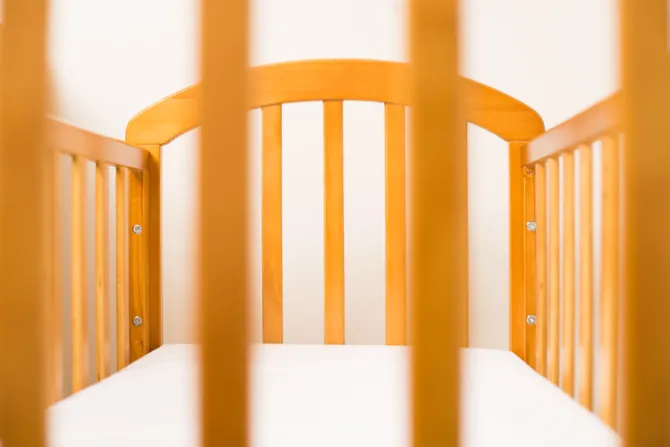Washington D.C., Dec 28, 2018 / 15:15 pm
Demographic reports indicate that the U.S. birth rate is at a 40-year low, with significant declines among Hispanic women. That low birth rate could mean declining Mass attendance because couples with children are more likely to attend church, one demographer says.
"It is the case that Catholics, Hispanic or not, tend to become more active in their faith when they marry and have children," said Dr. Mark Gray, senior research associate at the Georgetown University-affiliated Center for Applied Research in the Apostolate.
"Thus, going to Mass frequently may not necessarily make a couple more open to having more children. Instead, having children may encourage parents to incorporate their faith in their family life more and thus lead to higher levels of attendance."
Hispanic Catholics who attend Mass weekly on average have 2.89 children, compared to non-Hispanic Catholics who have 2.35, said Gray, citing General Social Survey figures.
"So it is accurate to say that more frequently Mass attending Catholics have more children," Gray told CNA. "Hispanics who are not Catholic have 1.8 children, on average. Nearly half of Hispanic adults are not Catholic, 46 percent."
At the same time, there are other aspects of the birth rate to consider.
"A growing rate of disaffiliation from Catholicism among Hispanics along with slightly lower rates of Mass attendance among Hispanic Catholics over the last decade could be having an effect on fertility decisions," Gray added. "The economy is also important."
The U.S. reached a 40-year low in the fertility rate, according to the Centers for Disease Control provisional estimate for 2017. There were about 3.85 million births last year, a total fertility rate of about 1.76 births per woman.
By comparison, the total fertility rate in 2007 was 2.08 children born per woman, with total births numbering as high as 4.31 million.
Lyman Stone, a research fellow at the Charlottesville, Va.-based Institute for Family Studies, said the Hispanic birth rate appears to have declined the most.
"Solidly half of the missing kids over the last decade would have been born to Hispanic mothers, despite the fact that Hispanics only make up about a quarter of fertility-age women," Stone said at the Institute for Family Studies website.
From 2008-2016, Hispanic women's age-adjusted fertility rate fell from 2.85 births per woman to 2.1. They had about 19 percent fewer babies than they were on pace to have before 2008. This numbers about 2.2 million "missing births," according to Stone.
By comparison, non-Hispanics' fertility rate fell from 1.95 births per woman to 1.72. About 2.3 million "missing births" would be from these mothers.
Stone credited the birth rate decline among all groups mostly to changes in marriage and marital status.
"Births to never-married women are down more than births to ever-married women," he said.
Since 2007, the age-adjusted fertility rate for married women is down 14 percent, while the never-married fertility rate is down 21 percent.
(Story continues below)
The statistics indicate the birth rate is falling more slowly for women with graduate degrees than women with bachelor's degrees, while the birth rate is falling most for women with no bachelor's degrees.
"Fertility declines are most strongly associated with factors that are race- or region-specific, not broadly class-specific, as different economic classes appear to have quite similar trends," Stone said. "This doesn't rule out all economic causes: there are important interactions between race and socioeconomic class."
He suggested that economically-oriented solutions may have only "modest direct effects" on the birth rate.
The CARA research blog, edited by Gray, took a look at a similar time period, 2010-2016. It found a net loss in the U.S. Catholic population of 0.9 percent.
"This is a dynamic that is happening at the level of the family where it meets the parish community. Something is disconnected," Gray said in a March 12, 2018 post.
Decline in marriage rates between Catholics and non-Catholics also mean a decline in non-Catholic spouses who convert to Catholicism. In 1996, 31 percent of all marriages were between Catholics and non-Catholics, compared to only 23 percent in 2015, Gray said.
"The most common reason given by adults converting to Catholicism for switching their religion is that they are marrying a Catholic. Fewer marriages in the Church between Catholics and non-Catholics will result in fewer adult entries into the faith."
The retention rate among Hispanic Catholics appears to be slipping.
In 2010, 77 percent of Hispanics who were raised Catholic remained Catholic when surveyed, compared to 64 percent of non-Hispanic Catholics. By 2016, only 69 percent of Hispanic Catholics remained Catholic, compared to about 63 percent of non-Hispanic Catholics.
In 2010, 63 percent of all Hispanic adults in the U.S. self-identified as Catholic, compared to 54 percent six years later.
"Declining affiliation among Hispanic Catholics should be of great concern to the Church because a majority of Catholics under the age of 18, those of the iGen, are Hispanic," said Gray, referring to the generation after the Millennials as "iGen."
He suggested that descendants of immigrants from predominantly Catholic countries often show diminishing religious affiliation over time.
"Coming from a very Catholic country to one with abundant religious pluralism … is a dramatic cultural change," he said.
The numbers could also reflect differences among Hispanics by national origin.
"In the United States, majorities of self-identified Mexicans, Dominicans, and Salvadorans self-identify their religion as Catholic," said Gray. "However, minorities of Cubans, Guatemalans, and Nicaraguans say they are Catholic."
More Mexican residents of the U.S. are returning to Mexico than entering, with a net population decline of about 140,000 U.S.-residing Mexicans from 2009 to 2014.
Catholic immigrants' numbers are also on the decline compared to other immigrants.
This article was originally published on CNA May 18, 2018.



